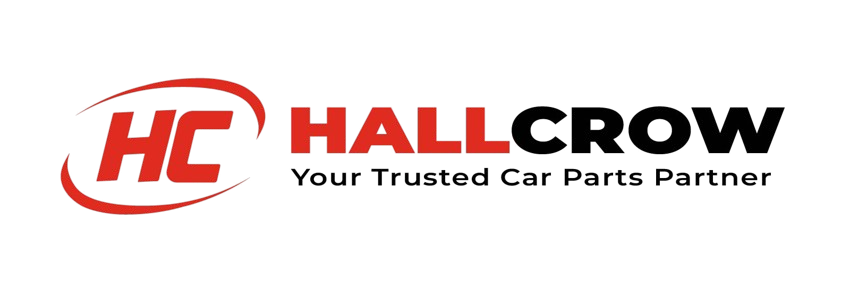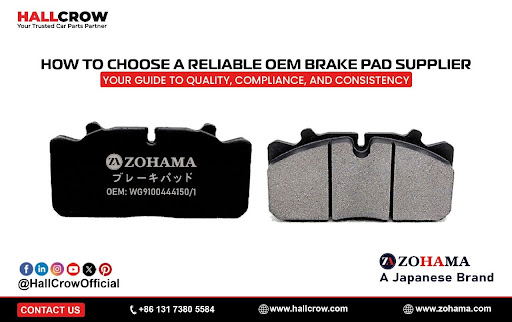Brake pads are more than just components—they’re critical to the safety and performance of any vehicle on the road. Whether it’s a commercial truck, daily commuter, or high-performance car, the quality of the brake pads can determine stopping distance, reliability under stress, and overall vehicle control.
For businesses that deal in vehicle repair, resale, or manufacturing, finding a reliable brake pad supplier isn’t just about price—it’s about ensuring consistent quality, safety, and availability. Dealerships, repair shops, and parts distributors can’t afford to gamble with substandard parts. In this guide, we’ll walk through the essential factors to consider when choosing an OEM brake pad supplier, so your business stays protected and your customers stay safe.
Understanding OEM Brake Pads
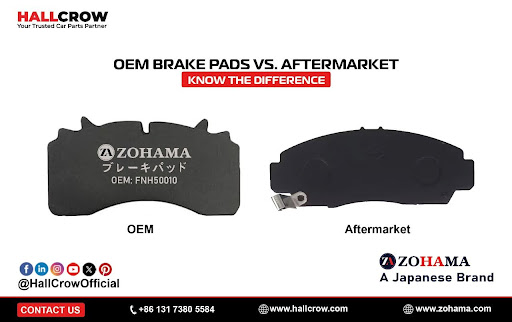
Before diving into what makes a supplier trustworthy, it’s important to get clear on the type of brake pads you’re sourcing. Not all pads are created equal, and the distinction between OEM and aftermarket products has major implications for performance, safety, and compatibility. Understanding how OEM brake pads work—and why they’re the preferred option for many professional buyers—sets the foundation for making smarter supplier decisions.
What Are OEM Brake Pads?
OEM, or Original Equipment Manufacturer, brake pads are designed to match the exact specifications of the vehicle’s original parts. They’re built to replicate the materials, shape, and performance of the components installed when the car first rolled off the assembly line.
Compared to aftermarket options, OEM brake pads deliver a more precise fit. They’re developed using vehicle-specific data, ensuring that when you install them, you maintain the integrity and safety of the vehicle’s braking system. For businesses, this means fewer issues with compatibility, reduced installation time, and better overall results for customers.
Why Choose OEM Over Aftermarket?
Choosing OEM brake pads over aftermarket alternatives often comes down to reliability and assurance. OEM pads typically meet the vehicle manufacturer’s standards for performance and durability. They are also more likely to be covered under vehicle warranties and may help maintain those warranties when used in repairs.
From a long-term business perspective, OEM brake pads reduce the risk of premature failures or customer returns. When you’re looking for consistent results and fewer post-sale issues, OEM is the safer path.
Key Qualities of a Reliable Brake Pad Supplier
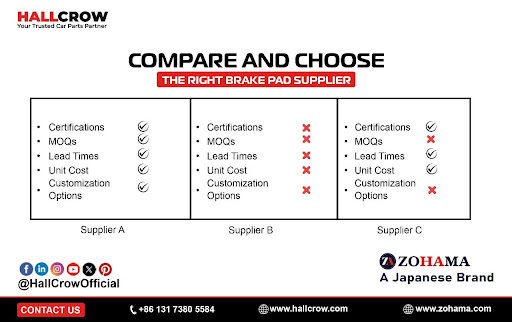
Once you understand the importance of OEM brake pads, the next step is evaluating the suppliers behind them. The right partner isn’t just producing pads that work—they’re producing parts that meet strict quality standards, back their claims with data, and maintain consistency batch after batch. Here’s what to look for when judging a supplier’s credibility and commitment to quality.
Product Quality and Certification
A brake pad supplier should be able to back their products with legitimate certifications. Reputable manufacturers will hold quality management certifications such as ISO 9001 or TS16949. These reflect a commitment to standardized production processes and quality assurance.
In addition to certifications, reliable brake pad manufacturers should provide detailed product testing data. This might include dynamometer tests, friction consistency reports, and heat resistance benchmarks. These reports give you a window into the supplier’s quality standards and commitment to performance.
Industry Reputation and Reviews
A supplier’s reputation speaks volumes. Look into how long the company has been in business, what markets they serve, and how clients perceive them. Online reviews, client testimonials, and even references from within your industry can offer insight into a supplier’s reliability.
If available, request case studies or examples of existing client relationships. These will give you a sense of how the supplier handles long-term partnerships and whether they’re a good fit for your specific business model.
Supplier’s Manufacturing Capabilities
Even if a supplier checks the boxes for quality, that doesn’t automatically mean they’re equipped to meet your business demands. Manufacturing capabilities—like scalability, material sourcing, and investment in research—can directly impact product availability, innovation, and your long-term growth as a distributor or reseller. Let’s break down what to ask about their production environment.
Production Capacity
One of the first things to evaluate is whether the supplier can handle your demand. Whether you’re stocking parts for a local chain of repair shops or managing inventory for an international distribution network, you need to know your supplier can deliver—especially during busy seasons.
Ask about the scale of their facilities, whether they use automated production lines, and how flexible they are with scaling output based on your needs.
Materials and R&D Focus
The best brake pad suppliers stay ahead by investing in new materials and product innovation. Find out whether your potential partner offers pads made from ceramic, semi-metallic, or organic compounds based on the needs of your customer base.
Also, ask if the supplier has an in-house R&D team. This is crucial if you’re looking to evolve your product line, respond to market trends, or customize brake pad characteristics for specific driving conditions or vehicle types.
Compliance and Safety Standards
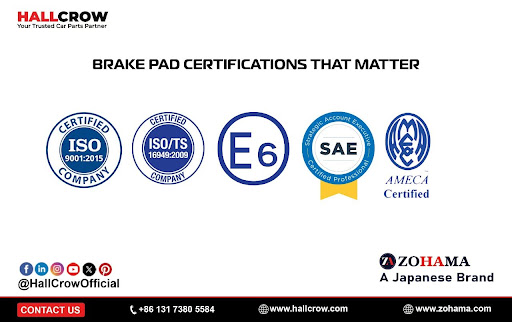
Brake pads are safety-critical components. That’s why regulatory compliance and certification should never be an afterthought. Any supplier worth considering should meet specific legal and technical standards that ensure their products are safe to install and sell—no matter where you operate. Here’s what to look for in terms of safety and environmental compliance.
Certifications to Look For
Brake pads aren’t just about stopping power—they’re also subject to legal and safety standards. Reputable suppliers will have products certified to meet regulations such as ECE R90 in Europe, SAE standards in the U.S., AMECA approval, and ISO 9001.
These certifications prove that the brake pads meet industry-approved performance and safety benchmarks. For any business that wants to avoid legal headaches and liability risks, this should be non-negotiable.
Environmental Standards
As environmental regulations evolve, it’s important to work with suppliers who are keeping pace. Ask whether the brake pads meet copper-free requirements, low-dust regulations, or are manufactured using sustainable methods.
Some manufacturers are now shifting to eco-conscious packaging and cleaner production processes. If your business is focused on sustainability, this can be a valuable point of alignment.
Customisation and Private Label Options
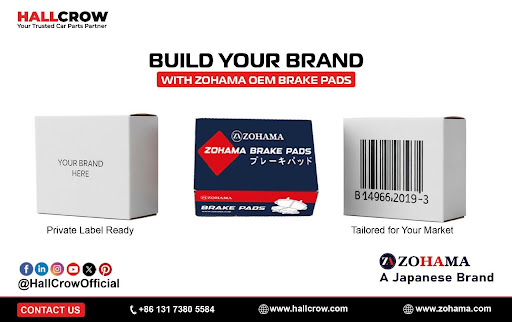
For many resellers and auto parts brands, the ability to personalize products can be a major advantage. Whether it’s adding your logo to the packaging or tailoring pad performance to a specific customer segment, the right supplier should offer flexible solutions to help you differentiate in the market. This section covers what customization options to ask about.
Branding and Packaging
If you’re planning to resell brake pads under your own brand, find out if the supplier offers private label services. Some brake pad suppliers provide custom branding and packaging that aligns with your business identity.
Having your logo and design on the packaging can enhance brand recognition and give your customers a more professional experience.
Flexible Design or Compound Adjustments
Different vehicles—and drivers—require different brake performance. A good supplier will offer options for compound customization. Whether you’re serving the needs of performance vehicles or daily commuter cars, the ability to fine-tune pad materials and behavior can be a major benefit.
Logistics and Supply Chain Management
Having a great product means little if it doesn’t arrive on time or in full. Efficient logistics and reliable supply chain practices are essential for staying ahead in today’s competitive auto parts market. A supplier’s ability to support your inventory flow, shipping needs, and documentation requirements will ultimately affect your service delivery and bottom line.
Delivery Timelines and Inventory Support
In the auto parts business, timing is everything. Look for brake pad suppliers that offer Just-in-Time (JIT) delivery models, or have the flexibility to stock products on your behalf.
Ask about lead times, minimum order requirements, and whether they can maintain buffer stock to support your seasonal or urgent needs. Consistent supply can keep your operations running smoothly.
Global Shipping and Export Capabilities
If your business operates internationally, your supplier needs to keep up. Choose a brake pad supplier that understands export documentation, customs procedures, and has a track record of successful global shipping.
The more experienced the supplier is with international trade compliance, the fewer issues you’ll encounter during cross-border transactions.
Pricing and Value for Money
Price is always a factor—but what you pay upfront isn’t the whole story. Evaluating a supplier’s pricing structure, transparency, and the total cost of ownership can help you avoid hidden expenses and get a better return on investment. In this section, we’ll look at how to assess real value beyond just unit cost.
Transparent Pricing Structure
Don’t let pricing surprises cut into your margins. A reliable supplier should clearly communicate their unit prices, discount tiers based on volume, and minimum order quantities.
Be wary of hidden charges or unlisted fees for shipping, labeling, or paperwork. A predictable pricing model helps you plan inventory and manage cash flow.
Total Cost of Ownership (TCO)
Price per unit doesn’t tell the full story. Consider what happens after the sale: Does the supplier offer technical documentation, installation guidance, or staff training? What’s their return policy if products don’t meet expectations?
Factoring in warranty support and product longevity will give you a more accurate sense of the overall value of your investment.
Communication and After-Sales Support
Your relationship with a brake pad supplier shouldn’t end after the first shipment. From technical assistance to warranty claims, strong communication and dependable after-sales support can save time and reduce friction when issues arise. Understanding how a supplier handles service after delivery is key to a stable partnership.
Responsiveness and Customer Service
Solid communication is a key part of any business relationship. A supplier should be responsive to inquiries and willing to answer technical questions. Ideally, you’ll have access to a dedicated account manager or a support representative who understands your account and your business needs.
A supplier that takes too long to respond or avoids addressing issues may cause delays that hurt your operations.
Technical Support and Warranty Claims
Even the best brake pads can face occasional issues. What matters is how the supplier handles them. Ask about the process for warranty claims and how they manage documentation.
Also, ensure that technical support is available if there are problems during installation or if unexpected product issues arise.
Comparing Multiple Suppliers: A Checklist
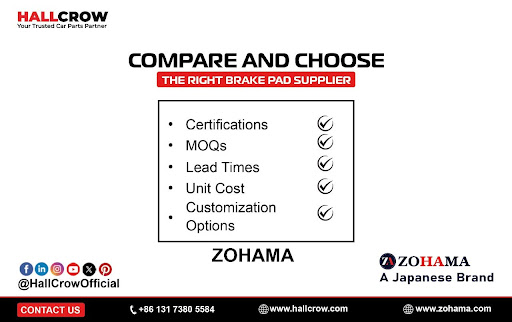
Now that you know what to look for in a supplier, it helps to compare options using a structured checklist. Laying out the key factors side by side makes it easier to evaluate which supplier offers the best mix of quality, service, and flexibility. This section outlines how to build that comparison framework.
When evaluating brake pad suppliers, create a side-by-side comparison table that helps you assess the critical variables:
- What quality certifications do they hold?
- How fast can they deliver your order?
- What are their MOQs (minimum order quantities)?
- What’s their per-unit cost based on your volume?
- How are they rated in terms of industry reputation?
- Do they offer strong customer service?
- Can they customize products or packaging?
This structured approach gives you a clear picture and helps prevent costly mistakes.
Red Flags to Avoid in Brake Pad Suppliers
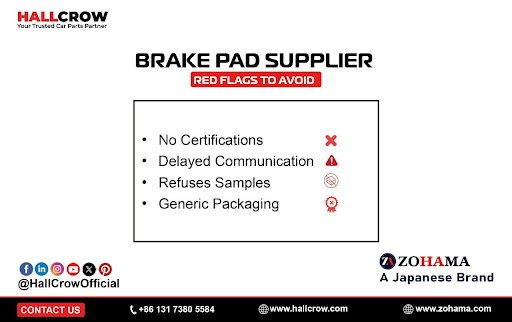
Just as there are qualities to seek out, there are also red flags to watch for. These warning signs—like vague certifications, poor communication, or sloppy packaging—can point to deeper problems that may cost you later. Being able to identify these risks early can protect your business and your customers.
Some warning signs are too important to consider. If a supplier isn’t upfront about where their products are made or cannot provide official certifications, that’s a major concern.
Poor or inconsistent communication is another issue, especially if it affects order timelines. Also, be cautious of any supplier that refuses to provide samples or technical data. These may indicate poor quality or lack of transparency.
Finally, pay attention to packaging. Weak labelling, flimsy boxes, or a lack of branding might reflect deeper issues with product care and professionalism.
Final Thoughts: Making the Right Choice
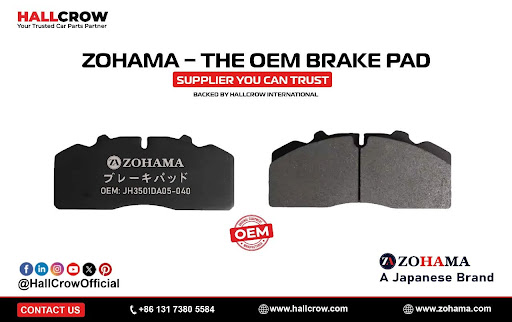
Selecting the right brake pad supplier is a decision that directly impacts your business reputation and customer satisfaction, from quality certifications and manufacturing strength to shipping reliability and after-sales support.
Zohama, the Japanese brand of HallCrow International, checks every box discussed in this guide. With international presence, strong R&D, and a commitment to safety and consistency, Zohama is positioned as a reliable long-term partner for businesses that want to source high-quality OEM brake pads with confidence.
Before you sign with any supplier, take the time to request samples, evaluate their processes, and compare their support structure. Choosing carefully now can prevent complications later, and set your business up for long-term stability and growth.
